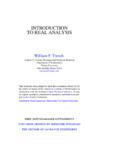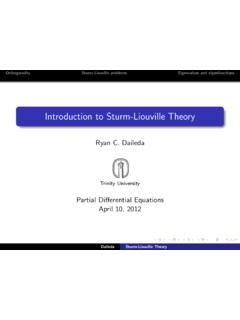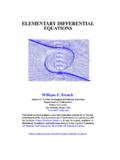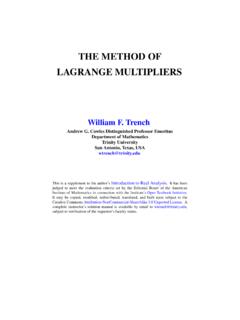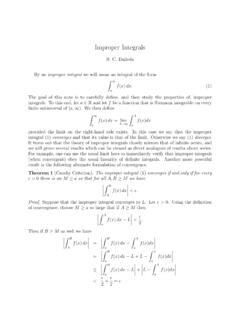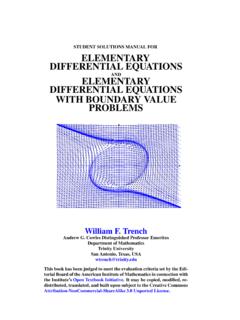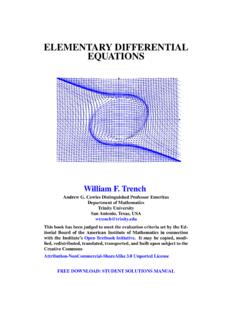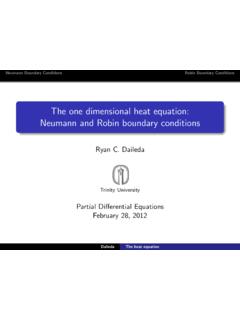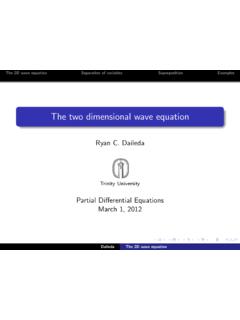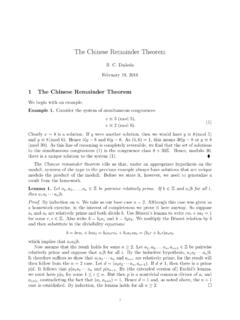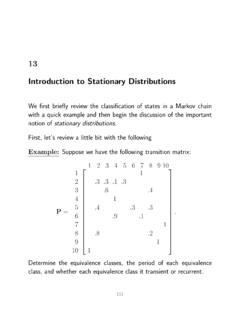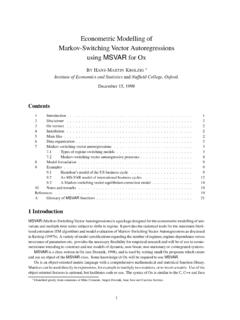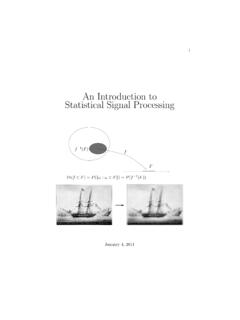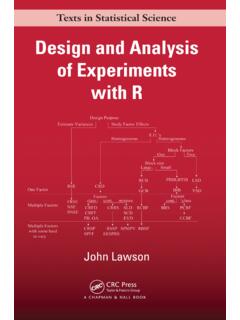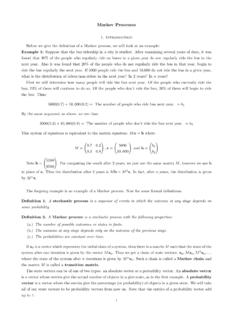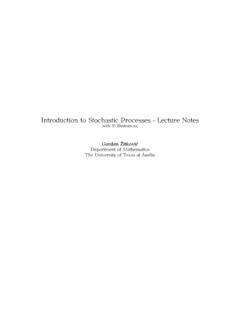Transcription of Probability, Statistics, and Stochastic Processes
1 probability , statistics , and StochasticProcessesProbability, statistics , andStochasticProcessesPeter OlofssonMikael AnderssonA Wiley-Interscience PublicationJOHN WILEY & SONS, York / Chichester / Weinheim / Brisbane / Singapore / TorontoPrefaceThe BookIn November 2003, I was completing a review of an undergraduate textbook in prob-ability and statistics . In the enclosed evaluation sheet was the question Have youever considered writing a textbook? and I suddenly realized that the answer was Yes, and had been for quite some time.
2 For several years I had been teaching acourse on calculus-based probability and statistics mainly for mathematics, science,and engineering students. Other than the basic probabilitytheory, my goal was to in-clude topics from two areas: statistical inference and Stochastic Processes . For manystudents this was the only probability / statistics course they would ever take, and Ifound it desirable that they were familiar with confidence intervals and the maximumlikelihood method, as well as markov chains and queueing theory.
3 While there wereplenty of books covering one area or the other, it was surprisingly difficult to find onethat covered both in a satisfying way and on the appropriate level of difficulty. Mysolution was to choose one textbook and supplement it with lecture notes in the areathat was missing. As I changed texts often, plenty of lecturenotes accumulated andit seemed like a good idea to organize them into a textbook. I was pleased to learnthat the good people at Wiley is now more than a year later, and the book has been first threechapters develop probability theory and introduce the axioms of probability , randomvariables, and joint distributions.
4 The following two chapters are shorter and of an introduction to nature: Chapter 4 on limit theorems and Chapter 5 on inference is treated in Chapter 6, which includes a section on BayesianvviPREFACE statistics , too often a neglected topic in undergraduate texts. Finally, in Chapter 7, markov chains in discrete and continuous time are introduced. The reference listat the end of the book is by no means intended to be comprehensive; rather, it is asubjective selection of the useful and the the text I have tried to convey an intuitive understanding of conceptsand results, which is why a definition or a proposition is often preceded by a shortdiscussion or a motivating example.
5 I have also attempted tomake the expositionentertaining by choosing examples from the rich source of fun and thought-provokingprobability problems. The data sets used in the statistics chapter are of three differentkinds: real, fake but realistic, and unrealistic but peopleMost textbook authors start by thanking their spouses. I know now that this is farmore than a formality, and I would like to thankA not only for patientlyputting up with irregular work hours and an absentmindedness greater than usual butalso for valuable comments on the aesthetics of the number of people have commented on various parts and aspects of the , I would like to thank Olle H aggstr om at Chalmers University of Technology,G oteborg, Sweden for valuable comments on all chapters.
6 His remarks are alwaysaccurate and insightful, and never obscured by unnecessarypoliteness. Second, Iwould like to thank Kjell Doksum at the University of Wisconsin for a very helpfulreview of the statistics chapter. I have also enjoyed the Bayesian enthusiasm of PeterM uller at the University of Texas MD Anderson Cancer people who have commented on parts of the book or been otherwise helpfulare my colleagues Dennis Cox, Kathy Ensor, Rudy Guerra, Marek Kimmel, RolfRiedi, Javier Rojo, David W.
7 Scott, and Jim Thompson at Rice University; Prof. Meester at Vrije Universiteit, Amsterdam, The Netherlands; Timo Sepp al ainenat the University of Wisconsin; Tom English at Behrend College; Robert Lund atClemson University; and Jared Martin at Shell Exploration and Production. For helpwith solutions to problems, I am grateful to several bright Rice graduate students:Blair Christian, Julie Cong, Talithia Daniel, Ginger Davis, Li Deng, Gretchen Fix,Hector Flores, Garrett Fox, Darrin Gershman, Jason Gershman, Shu Han, ShannonNeeley, Rick Ott, Galen Papkov, Bo Peng, Zhaoxia Yu, and Jenny Zhang.
8 Thanks toMikael Andersson at Stockholm University, Sweden for contributions to the problemsections, and to Patrick King at ODS Petrodata, Inc. for providing data with a dis-tinct Texas flavor: oil rig charter rates. At Wiley, I would like to thank Steve Quigley,Susanne Steitz, and Kellsee Chu for always promptly answering my questions. Fi-nally, thanks to John Haigh, John Allen Paulos, Jeffrey E. Steif, and an anonymousDutchman for agreeing to appear and be mildly mocked in , Texas, 2005 PREFACEviiPreface to the Second EditionThe second edition was motivated by comments from several users and readers thatthe chapters on statistical inference and Stochastic Processes would benefit from sub-stantial extensions.
9 To accomplish such extensions, I decided to bring in MikaelAndersson, an old friend and colleague from graduate school. Being five days my ju-nior, he brought a vigorous and youthful perspective to the task and I am very pleasedwith the outcome. Below, Mikael will outline the major changes and additions intro-duced in the second OlofssonSan Antonio, Texas, 2011 The chapter on statistical inference has been extended, reorganized and split intotwo new chapters. Chapter 6 introduces the principles and concepts behind standardmethods of statistical inference in general while the important special case of normallydistributed samples is treated separately in Chapter 7.
10 This is a somewhat differentstructure compared to most other textbooks in statistics since common methods likettests and linear regression come rather late in the text. According to my experience,if methods based on normal samples are presented too early ina course, they tend toovershadow other approaches like nonparametric and bayesian methods and studentsbecome less aware that these alternatives additions in Chapter 6 include consistency of point estimators, large sam-ple theory, bootstrap simulation, multiple hypothesis testing, Fisher s exact test.
